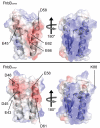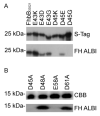Sequence divergence in the Treponema denticola FhbB protein and its impact on factor H binding
- PMID: 23601078
- PMCID: PMC3785937
- DOI: 10.1111/omi.12027
Sequence divergence in the Treponema denticola FhbB protein and its impact on factor H binding
Abstract
Treponema denticola is an anaerobic spirochete whose abundance in the subgingival crevice correlates with the development and severity of periodontal disease. The ability of T. denticola to survive and thrive in the hostile environment of the periodontal pocket is due, at least in part, to its ability to bind factor H (FH), a negative regulator of the alternative complement pathway. The FH binding protein of T. denticola has been identified as FhbB and its atomic structure has been determined. The interaction of FH with T. denticola is unique in that FH bound to the cell surface is cleaved by the T. denticola protease, dentilisin. It has been postulated that FH cleavage by T. denticola leads to immune dysregulation in periodontal pockets. In this study, we conduct a comparative assessment of the sequence, properties, structure and ligand binding kinetics of the FhbB proteins of strains 33521 and 35405. The biological outcome of the interaction of these strains with FH could differ significantly as 33521 lacks dentilisin activity. The data presented here offer insight into our understanding of the interactions of T. denticola with the host and its potential to influence disease progression.
Keywords: complement; factor H; immune evasion; periodontitis.
© 2013 John Wiley & Sons A/S. Published by John Wiley & Sons Ltd.
Figures










Similar articles
-
Analysis of the complement sensitivity of oral treponemes and the potential influence of FH binding, FH cleavage and dentilisin activity on the pathogenesis of periodontal disease.Mol Oral Microbiol. 2014 Oct;29(5):194-207. doi: 10.1111/omi.12054. Epub 2014 Jun 3. Mol Oral Microbiol. 2014. PMID: 24815960 Free PMC article.
-
Identification of the primary mechanism of complement evasion by the periodontal pathogen, Treponema denticola.Mol Oral Microbiol. 2011 Apr;26(2):140-9. doi: 10.1111/j.2041-1014.2010.00598.x. Epub 2010 Dec 3. Mol Oral Microbiol. 2011. PMID: 21375704 Free PMC article.
-
Analysis of a unique interaction between the complement regulatory protein factor H and the periodontal pathogen Treponema denticola.Infect Immun. 2009 Apr;77(4):1417-25. doi: 10.1128/IAI.01544-08. Epub 2009 Feb 9. Infect Immun. 2009. PMID: 19204088 Free PMC article.
-
Approaches to Understanding Mechanisms of Dentilisin Protease Complex Expression in Treponema denticola.Front Cell Infect Microbiol. 2021 May 18;11:668287. doi: 10.3389/fcimb.2021.668287. eCollection 2021. Front Cell Infect Microbiol. 2021. PMID: 34084756 Free PMC article. Review.
-
Gene Regulation, Two Component Regulatory Systems, and Adaptive Responses in Treponema Denticola.Curr Top Microbiol Immunol. 2018;415:39-62. doi: 10.1007/82_2017_66. Curr Top Microbiol Immunol. 2018. PMID: 29026924 Review.
Cited by
-
Analysis of the complement sensitivity of oral treponemes and the potential influence of FH binding, FH cleavage and dentilisin activity on the pathogenesis of periodontal disease.Mol Oral Microbiol. 2014 Oct;29(5):194-207. doi: 10.1111/omi.12054. Epub 2014 Jun 3. Mol Oral Microbiol. 2014. PMID: 24815960 Free PMC article.
-
Molecular Analysis of Aggregatibacter actinomycetemcomitans ApiA, a Multi-Functional Protein.Pathogens. 2024 Nov 18;13(11):1011. doi: 10.3390/pathogens13111011. Pathogens. 2024. PMID: 39599564 Free PMC article.
-
The Treponema denticola FhbB Protein Is a Dominant Early Antigen That Elicits FhbB Variant-Specific Antibodies That Block Factor H Binding and Cleavage by Dentilisin.Infect Immun. 2016 Jun 23;84(7):2051-2058. doi: 10.1128/IAI.01542-15. Print 2016 Jul. Infect Immun. 2016. PMID: 27113359 Free PMC article.
-
Topology and functional characterization of major outer membrane proteins of Treponema maltophilum and Treponema lecithinolyticum.Mol Oral Microbiol. 2025 Feb;40(1):17-36. doi: 10.1111/omi.12484. Epub 2024 Sep 12. Mol Oral Microbiol. 2025. PMID: 39263909
-
The Cross-Talk between Spirochetal Lipoproteins and Immunity.Front Immunol. 2014 Jun 30;5:310. doi: 10.3389/fimmu.2014.00310. eCollection 2014. Front Immunol. 2014. PMID: 25071771 Free PMC article. Review.
References
Publication types
MeSH terms
Substances
Grants and funding
LinkOut - more resources
Full Text Sources
Other Literature Sources
Miscellaneous

